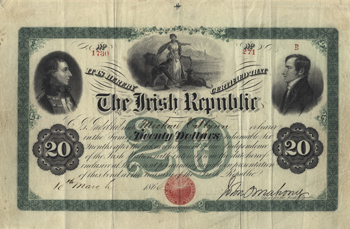Collections Online
The Irish Republic
To order an image, navigate to the full
display and click "request this image"
on the blue toolbar.
-
Choose an alternate description of this item written for these projects:
- Main description
[ This description is from the project: Object of the Month ]
Founded on Saint Patrick's Day in 1858, the Irish Republican Brotherhood (IRB) was a secret revolutionary society that grew out of the Fenian movement. Fenianism (the name refers to the Na Fianna—the warriors of the kings of ancient Ireland) originated among Irish immigrants in the United States where there was strong support for Irish independence.
In 1865, the Fenian Brotherhood, an American sister organization of the IRB sold bonds, including this 1866 bond, to raise money to support the republican cause. John O'Mahony, the leader of the IRB in the United States, signed this bond that features images of (Theobald) Wolfe Tone and Thomas Davis, two early proponents of Irish nationalism, as well as a radiant woman who represents Ireland herself, calling the nation to arms. William Butler Yeats later depicted this woman, "for whom so many songs have been sung and about whom so many stories have been told," in his play, Cathleen ni Houlihan (1902).
The Fenians launched raids on British Canada from the United States in 1866 and staged short-lived risings in Ireland in 1867. However, the IRB lacked popular support and ceased military operations in 1873, stating that they would await "the decision of the Irish nation, as expressed by the majority of the Irish People."
A generation later, the republican movement rose anew. On Easter Monday 1916, members of the IRB coordinated a rising and captured public buildings throughout Dublin. The British government suppressed the insurrection with great severity and executed many of the leaders, but as Yeats had foreseen in Cathleen ni Houlihan:
"They shall be remembered forever,
They shall be alive forever,
They shall be speaking forever,
The people shall hear them forever."
The Irish population came to see the executed leaders of the Easter Rising as martyrs to the cause of Irish freedom and demanded independence from Great Britain.
Both this bond and a later bond issued by the Irish revolutionary government are from the records of the Charitable Irish Society on deposit in the library of the Massachusetts Historical Society.

